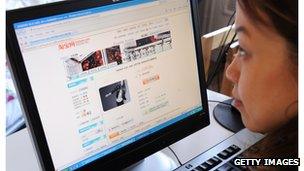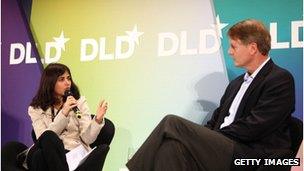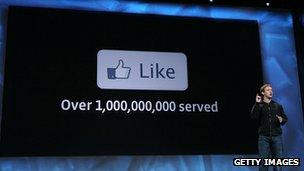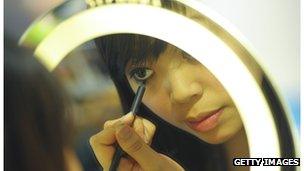The search for e-commerce 3.0
- Published

The Chinese online market place Taobao sells 800 items a second
E-commerce - the term sounds nearly old-fashioned by now. Aren't we all doing our shopping online?
Well, no. E-commerce is still puny. By some estimates it makes up a mere 5% of all retail.
But it is growing rapidly.
Some of the data points are startling: The Chinese online market place Taobao, for example, sells 800 items a second. German carmaker Volkswagen deals with its suppliers online, in a business-to-business market that turns over 2bn euros a year, according to consultancy Booz & Co.
E-commerce is disrupting more and more markets. This is not just about buying your music, books, travel and electronics online.
One third of all offline buying decisions in bricks-and-mortar shops are now influenced by online behaviour, says Sonali de Rycker, e-commerce specialist at venture capital firm Accel Partners.
E-commerce 1.0 was all about discovering the web and setting up the first online shops. They were imitations of the offline world, with virtual shelves providing breadth and depth of product.

Sonali de Rycker with John Donahoe, president of eBay at the DLD 2012 conference in Munich
Version 2.0 saw these websites transformed into clever multimedia portals that tried to engage users. They were not just about "pull", where shoppers searched for a specific product and bought it, they were also "push" - convincing customers to snap up that special deal, to follow an impulse, says Ms de Rycker.
Now e-commerce 3.0 is slowly emerging - except nobody is quite sure yet what it will look like.
The quest to get closer to customers featured heavily on the agenda at DLD conference in Munich, a gathering of entrepreneurs, investors and technologists from Europe, North America and beyond, held every year just before the start of the World Economic Forum in Davos.
For conference participants it was a given that "digital is destroying analogue business models", as one of them put it.
Now, however, this disruptive online world is beginning to invade the world of bricks-and-mortar, and its new driving forces are social networks and mobile phones.
Shopping alone, with friends
Shopping should be fun. You go shopping with friends or your partner, discuss what to buy, give and receive tips, wait for compliments as you try on a dress or select a new gadget.

Fans rate custom-made content for Facebook with a "like", which creates a buzz around a company's products
"Remember that shopping is a very social experience," says Ms de Rycker, that "online made… very clinical."
The rise of social networks is changing all that. According to internet metrics firm Comscore, one in five online minutes is now spent on social networks.
Or as Marc Benioff, the boss of cloud software firm salesforce.com, likes to put it: "Facebook is eating the internet."
Combine this network effect with online shopping and you fundamentally change how shoppers behave and how businesses have to operate.
Start with advertising. "We don't fill empty [advertising] holes on websites any more, we engage customers," says Michael Lazerow, chief executive of Buddymedia.
He points to companies like Walmart and Best Buy, with their carefully targeted online promotions advertising and online communities where customers share their likes with friends and family.
Linda Abraham, chief executive of Comscore, believes that websites like Facebook are central for companies to engage their customers.
And this engagement, she says, has a measurable return on investment - if it's done the right way.
The Facebook effect
Attract fans, she says. Put creative brand messages in their news feed to cut through. If it's well done, fans will talk about that content and "like" it on Facebook. This content then spreads to friends, amplifying the message. Which in turn results in sales with maximum returns on the investment.
Too many companies, says Ms Abraham, forget about the three steps in the middle, and fail with their efforts.

US cosmetics chain Sephora has built up a social online experience where female customers share their cosmetics tips
She cites one example where Walmart got a direct "paid" return of $257 for its direct advertising spend aimed at the company's Facebook fans, but made another $1,173 of revenue as the message spread through their network of friends.
Social, however, is more important than that. Comscore analysis suggests that the actual shopping behaviour of a company's fans is closely mirrored by their friends.
During the recent shopping season, especially the weekend after Thanksgiving, many US retailers saw a tremendous lift through offers given to fans, which were then passed around to friends and family.
US cosmetics chain Sephora, with the help of social media specialists Lithium, has built up a social online experience where female customers share their cosmetics tips - which extends onto the shop floor. Check out a colour of lipstick or nail varnish and ask your online friends whether it suits your type.
More than 80% of online shoppers, says Ms de Rycker, let themselves to be guided by product reviews of their peers.
But Ms De Rycker warns that companies cannot just add a social component to their e-commerce operation. "Social," she says, "has to be part of the DNA of how you sell online."
And nothing is more social than games. Fantasyshopper.com is a British start-up based in Exeter, that has just gained the backing of a stellar cast of angel investors and venture capital firms (including Accel Partners).
Its website is a game, where people can use (free) play money to go shopping virtual versions of real products. Friends give feedback on clothing, recommend other outfits - and Fantasyshopper.com earns money when users click through to the real online shops and buy.
Launched one month ago, the website is growing rapidly in the UK and has plans for international expansion.
Chris Prescott, the founder and chief executive of the start-up, explains the appeal: "You're a young guy and you've bought two different pairs of jeans on Fantasyshopper. For one of them five girls say you'll look good in them, the other gets no votes. Which one are you going to buy in real life?"
Mobile impact
The real game changer, though, will be the combination of social online shopping with mobile phones.
Smartphone owners are much more likely to abandon a purchase in a bricks-and-mortar store, because they can get instant reviews, feedback and price comparisons for products on the shelf.
"One in every three mobile (shopping) transactions is done while in a store," reports Ms de Rycker
But what if companies can turn this to their advantage, and deliver a good mobile shopping experience?
David Sable, global chief executive of advertising firm Young & Rubicam, calls mobile phones "the ultimate combination of digital and real life".
He says that they will not just change e-commerce as such, they will change retail itself.
Ms De Rycker says that as "mobile integrates social and retail, [it] will drive a whole new customer behaviour".
Andrew Mason, the chief executive of discount voucher firm Groupon (another of Accel Partner's many investments), told DLD that his firm was trialling a new real-time deal service, where users can check on their mobile phone whether any deals are on offer right now within a few blocks of their location.
As more and more people join the aways-on, always-connected world, the amount of information available to retailers is going to be of staggering proportions.
Cloud computing makes processing these data fairly easy. But which companies will be able to interpret the data in a meaningful way, and use them as a strategic asset?
Those that do will be the big winners of e-commerce 3.0.
- Published8 March 2012
- Published18 January 2012
- Published17 January 2012
- Published17 October 2011